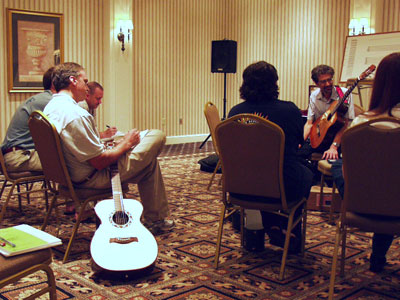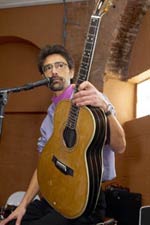Workshops & Private Instruction > Workshops


Arranging Songs For Solo Guitar, Some Fingerboard Mapping & A Little Theory
The concept is simple enough: melody + chords = song. Making the result musical is maybe another subject entirely, but we can at least analyze the necessary components and frame them within the constructs of the guitar fingerboard. Playing techniques and ways to simplify will be emphasized. Some of what will be discussed may include:
- Chord components and their relationship to scales and melodies.
- Using the five primary chord shapes and the octave grid as the foundation for rendering chords, and framing melodies.
- Points of Reference: position markers. tuning positions, harmonics placement, the octave grid, open strings, scale layouts both across and along the fingerboard.
- Horizontal & Vertical: the linear aspects of fingering in melody and chord motion.
- Strategies for what key to play in. Keeping the melody on top of the chord. Keeping the melody within reach of the chord.
- Choosing a song that works on the guitar.
Players of any level are welcome.
Mapping the Fingerboard
- What if there were only One String?
- Points of Reference: where the note is, fretboard markers and the octave grid.
- Nut to Bridge, String to String: the linear aspects of fingering in melody and chord motion.
- Chord Components and their relationship to scales. Scale layouts both across and along the fingerboard.
- Why Standard Tuning produces only five primary chord shapes: E, A, D, G, & C. (What happened to B?)
- Using the Five Shapes and the Octave Grid as framework for understanding and cataloguing everything else: scales, melodies, riffs, bass runs, other chords...
- Tying this all together to play songs: As accompaniment to vocals, as material for solo arrangements.
Players of any level are welcome.
Alternate Tunings
- A brief discussion of why Standard Tuning is the norm.
- Starting from Standard Tuning and developing alternate tunings from there.
- Common and some not so common Alternate Tunings.
- Simple Fingerings to create or imply full chords, complex chord fingerings, a few scales & arpeggios.
- Using things you know in Standard Tuning to inform the learning process in an Alternate Tuning.
- Harmonic content: the “tuning’s voice”
- Notation Methods and keeping track of tunings using TAB, standard notation, and “chicken scratching”.
- Handouts: Tunings list; diagrams; picking patterns and other tricks, lists of songs, players and suggested books.
- A song or two to take with you.
Players of any level are welcome.
Return to the top of the page.
Home ::
Calendar ::
Listen & Watch ::
Recordings ::
Photo Galleries ::
Press ::
Bio ::
Workshops & Private Instruction ::
About Stanley Watson ::
Mad Scientist Guitar Projects ::
Contact & Booking ::
Photos & Posters for booking ::
Links
©Copyright 2007-2024, Kinoch Nelson, All Rights Reserved
Design by GCN, development by Red Beagle Web Development















